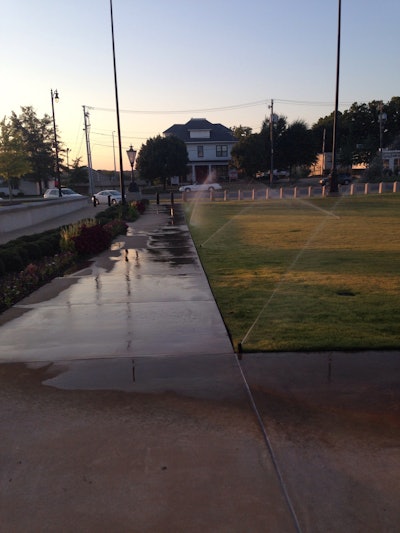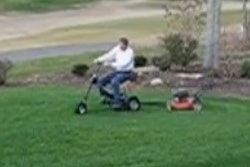
Unfortunately, the more you learn about irrigation, the more you realize how many people aren’t following the proper procedures.
So, needless to say, my friends have all started to hate me because I continuously point out all of the flaws when we pass irrigation problems.
For instance, I took this photo while I was out, because I can’t stand sprinklers watering sidewalks. Not to mention this photo was taken at 7 p.m., which is a terrible time to be watering the grass (or sidewalks).
This is just one of several instances I have seen throughout Smart Irrigation Month. I have see broken sprinklers, sprinklers going at 12 p.m., sprinklers running in the rain and so much more.
Want to know the worst part?
Professional landscaping crews run most of these sprinkler systems.
There is no excuse for landscapers to not know the ins and outs of irrigation procedures and systems.
I think the State of California would agree with me.
According to the Environmental Protection Agency, 40 out of 50 state water managers expect water shortages under average conditions in some portion of their states over the next decade.
RELATED: 4 Ways to Maintain Sprinkler Systems
Rain Bird offers a few tips on how to save water, including dividing water by zones, when to water and maintaining the system.
For instance, the company says to put out measuring cups in various places around the yard and run the sprinklers for 15 minutes.
“This will give you an idea of how much water the grass is getting and where,” Rain Bird says. “You’re looking for about 1 to 2 inches—depending on the soil—evenly distributed. An underground sprinkler system is probably the best way to be sure the lawn is evenly covered.”
Additionally, the company says to “water only what grows”.
If the sprinkler system is underground, landscapers need to make sure the heads are adjusted properly to avoid watering the sidewalks.
“A properly adjusted sprinkler head should spray large droplets of water, not a fine mist, to minimize evaporation and wind drift,” the company says.
Here are five fast irrigation fixes from Rain Bird:
1. Misaligned heads: Adjust any sprinkler heads that may have shifted and are watering the street, patio, sidewalk or driveway.
2. Obstructed heads: Taller grass around sprinkler heads may block your intended spray pattern and prevent water from reaching your lawn or other plants. Make sure you have at least 3- or 4-inch pop-up sprinklers to fully clear taller grass. You may also need to trim back overgrown plant material that may be blocking the spray.
3. Broken parts: Look for parts that may have been broken by lawnmowers or foot traffic. Replace any broken parts, being sure to match the spray pattern and distance for peak performance.
4. Clogged nozzles: Dirt, small rocks or other debris can occasionally clog sprinkler heads. If you notice any heads that appear clogged, simply turn off the zone, unscrew the nozzle, then rinse the nozzle and filter screen in some clean water. Once cleared, replace the nozzle and filter screen, checking to make sure the spray is aligned properly.
5. Head-to-head coverage: For even, efficient watering, each sprinkler’s spray should just reach the next sprinkler head. Under-spray may result in dry spots that can eventually turn brown, while over-spray wastes water.
What is the worst irrigation mistake you have seen?









